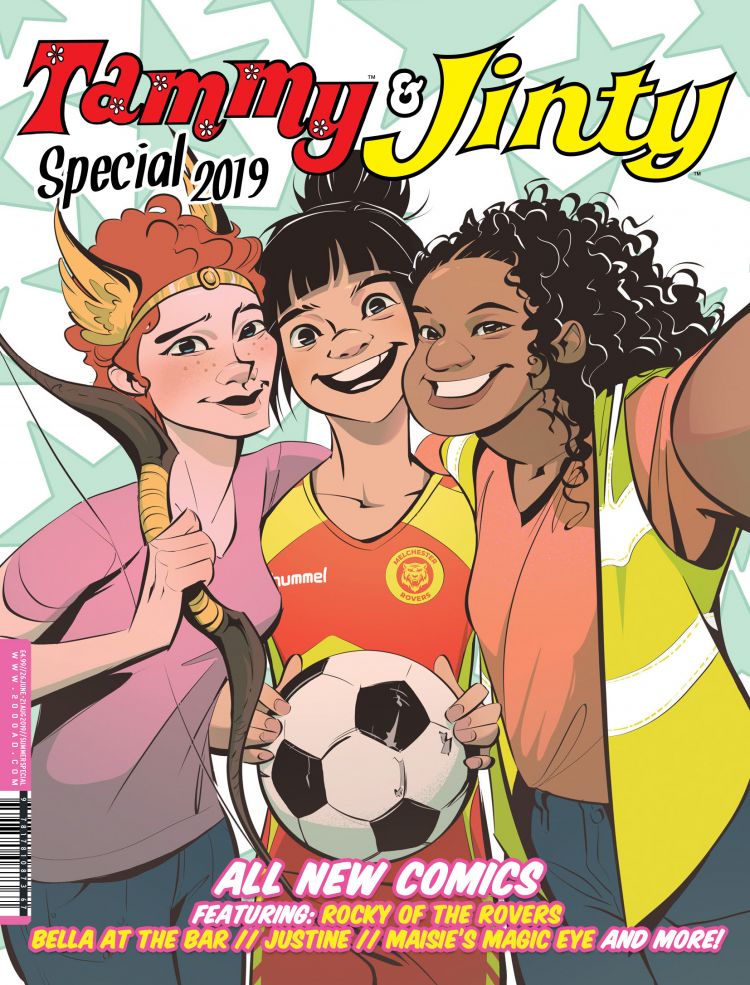Interview: RAMZEE & Elkys Nova on bringing back Cat Girl in the Tammy & Jinty Special
8th August 2020
The year’s been rather rubbish so far for sure – so what you need is something to brighten the mood of doom & gloom. We’ve got the perfect answer with the brand new Tammy & Jinty Special!
Inside, you’ll find two spectacular tales of courage and awe; Boarding School by Rachael Smith (Wired Up Wrong) and Yishan Li (Hellboy & The B.P.R.D.) and Cat Girl by RAMZEE (Zorse) and Elkys Nova (Roy of the Rovers), all under a cover from Marguerite Sauvage (DC Bombshells).
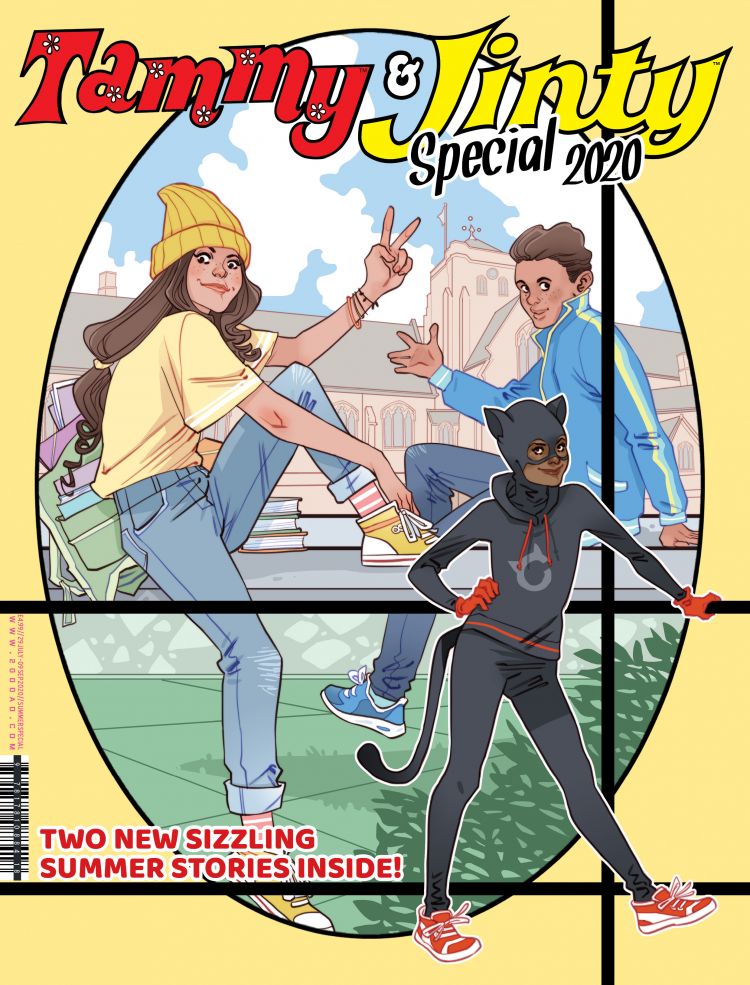
With Cat Girl, RAMZEE & Elkys Nova bring a classic character back when an old favourite from the pages of the Sally returns. Fourteen-year-old Claire finds an old cat costume in her mother’s wardrobe and wears it to a social media star’s party, unware that she has just donned the magical mantle of the super-sleek crime fighter, Cat-Girl!
Make sure you pre-order your copy from the Treasury of British Comics webshop, or grab yours from all good newsagents and comic book shops on 12 August!
PRE-ORDER NOW
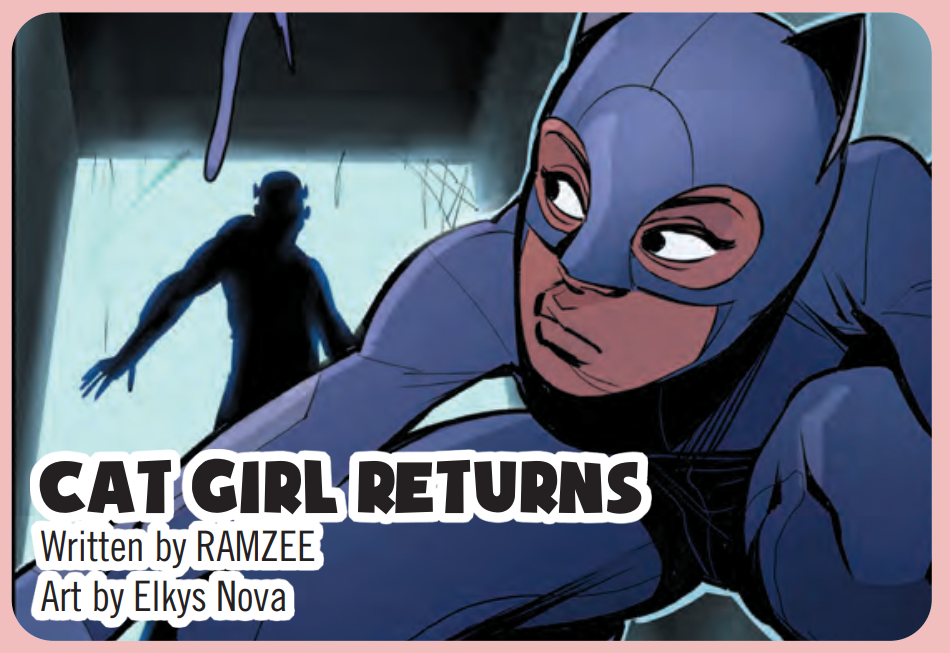
First things first, you’re both responsible for one half of the new Tammy & Jinty Special with the strip Cat Girl, a redoing of a classic superhero from the pages of Sally (art by Giorgio Giorgetti and debuting in 1969).\
So, what’s the new strip about?
RAMZEE: Our new Cat Girl strip is about the original Cat Girl‘s daughter, Claire, who ‘borrows’ a vintage costume from her mum’s wardrobe and wears it to a Halloween party thrown by Lottie Rose – a social media star – Claire is unaware that her costume is actually the magical Cat Girl costume. Whilst across town, her Police Detective mother is investigating a mystery of a thief who is targeting the cities most wealthy, their next target being Lottie Rose!
What elements of the original will you be keeping, what modifications have you made?
RAMZEE: I loved the Father/Daughter dynamic of the original strip and that the stories were largely mysteries with a superhero element to them. I thought that it would be cool in this modern-day interpretation of Cat Girl for it to be a Mother/Daughter dynamic because Mother/Daughter legacy characters are rare in comics generally, and as well as to make Claire biracial, because why not? And there is a lack of Girls of Colour in UK Comics. I also wanted to set it firmly in these social media addled times to satirise it!
Elkys Nova: It is so good the way that Ramsey makes reference to the original Cat Girl, letting the readers know that this could be a canon story that is happening right in 2020, showing how much time has passed and what new to come with this heroine. I personally wanted to keep the structure of the original Cat Girl costume and add some little details that could make it look memorable and singular among other heroes design.
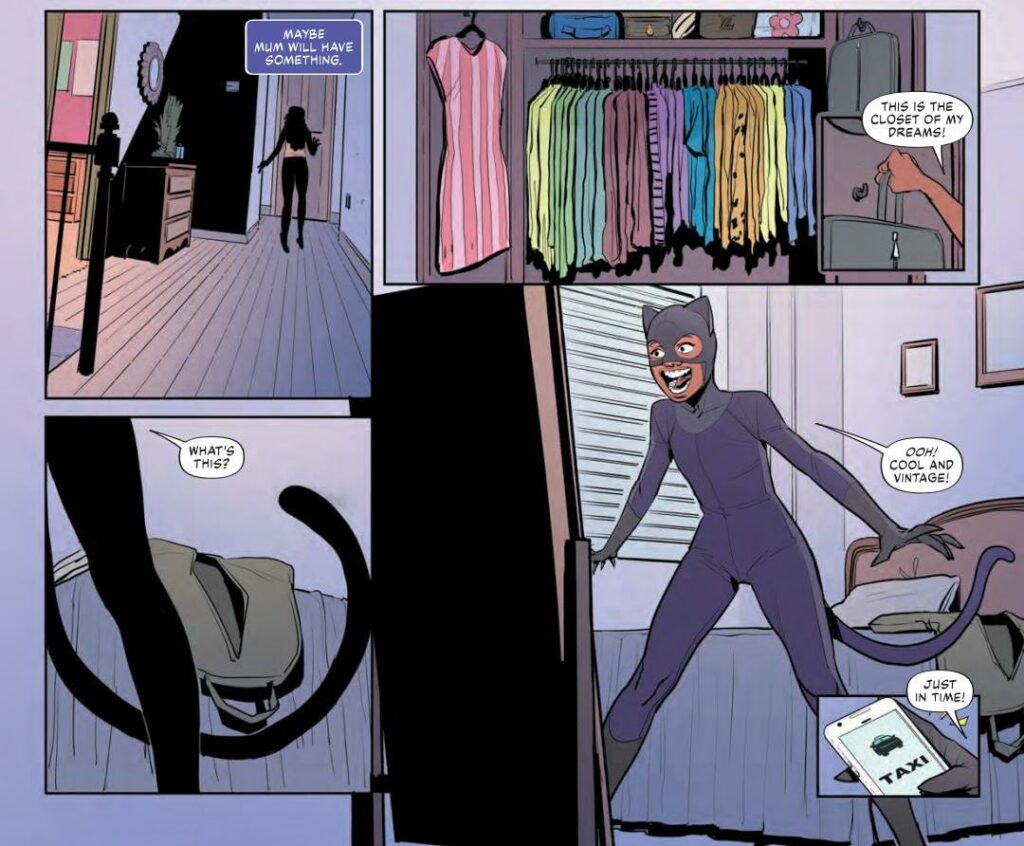
RAMZEE, back in 2015, I remember seeing and reviewing your book Triangle, saying how you’d got real potential, delivering ‘three really good Future Shock-ish tales. In all honesty, with a tweak here and there, the first couple of tales… could easily get into 2000AD. The only reason third tale Meet Cute wouldn’t work is that it’s Ramzee’s twisty take on classic Rom-Coms (and I do enjoy a good rom-com).’
So, although you haven’t made it into 2000 AD (yet), what’s it feel like to have your first pro story out here in the pages of Tammy & Jinty?
RAMZEE: I am absolutely honoured. I was a big fan of the last Tammy and Jinty Summer Special and there’s so much energy, wit and psychological depth to those stories – it’s a great canvas to draw on. Pat Mills and Sean Phillips are big heroes of mine and they both got their start in British Girls comics, I think, so I’m happy to be following in their footsteps too.

Elkys, you came new to me when you had art duties on the recent Roy Of The Rovers Euro Adventure strip in the ROTR Summer Special. Likewise to you – how did it feel to be part of the legend that is ROTR?
EN: For me it was an honour being part of a football classic comic. When I was a little kid I would hang out a lot with my cousins, who had football in their veins. I used to go play with them and have so much fun.
A big part of the ROTR comic that I took part in was inspired by the classic Roy and my childhood experience about this sport. It was so inspiring having all those memories of being in the field kicking the ball that I could empathize a lot with the characters and honest art to what was happening in the story.
How did you both get to be where you are?
RAMZEE: I’m a Small Press Comics Creator from London – so I made my own comics and put them in shops and tabled them at fairs and conventions. I’ve self-published three popular books. The second of which was nominated for a British Comic Award back in 2016 in the YA category (the only self-published book on the shortlist) which was pretty cool.
EN: I first started working on comics at the age of 14, but had been drawing since I can remember. Honestly, I could remember drawing before anything. And loving telling stories guided me to MoroStudio, the company where I developed as an artist. If it wasn’t for them I probably wouldn’t get this far.
In 2014, I got my first international gig, drawing 3 comic pages for a sci-fi comic from the States. After that, started working on some MoroStudio projects, alongside my very good friend Jorge E. Perez Miliano. And in the meantime, I decided to do little gigs, so I could keep working on personal projects. On 2018, I wanted to start studying art, because basically most of my art knowledge had been self-taught, reading art books and practising a lot to get better. So I applied for a scholarship at Chavón (art’s school). After almost two years, I went back to MoroStudio to put everything I learned into practice.
And how did you both get involved in this new Tammy & Jinty Special?
RAMZEE: A fantastic editor at Rebellion picked up my work, liked it and invited me to pitch. I was packing for the Thought Bubble Festival when I got the email – excited about the festival but also a bit melancholy – ‘Will I make enough money to cover my table? Will I be able to meet any editors?’ – So it was very welcome news!
EN: I got an email from my very good friend Lisa Henke, asking me if I would like to work on a football special, on the title she’d been working on. So I said OF COURSE! And here we are.
While I was working on ROTR, I got a proposal from Keith Richardson to work on the Cat Girl’s comic strip. I have to admit I did not know about this heroine before. I decided to investigate about the character and its origins so I could get familiar with it, take the essence of the whole mood the story presents, to then try to mix it with some contemporaneous comic concept. Always trying to honour the classic strip.
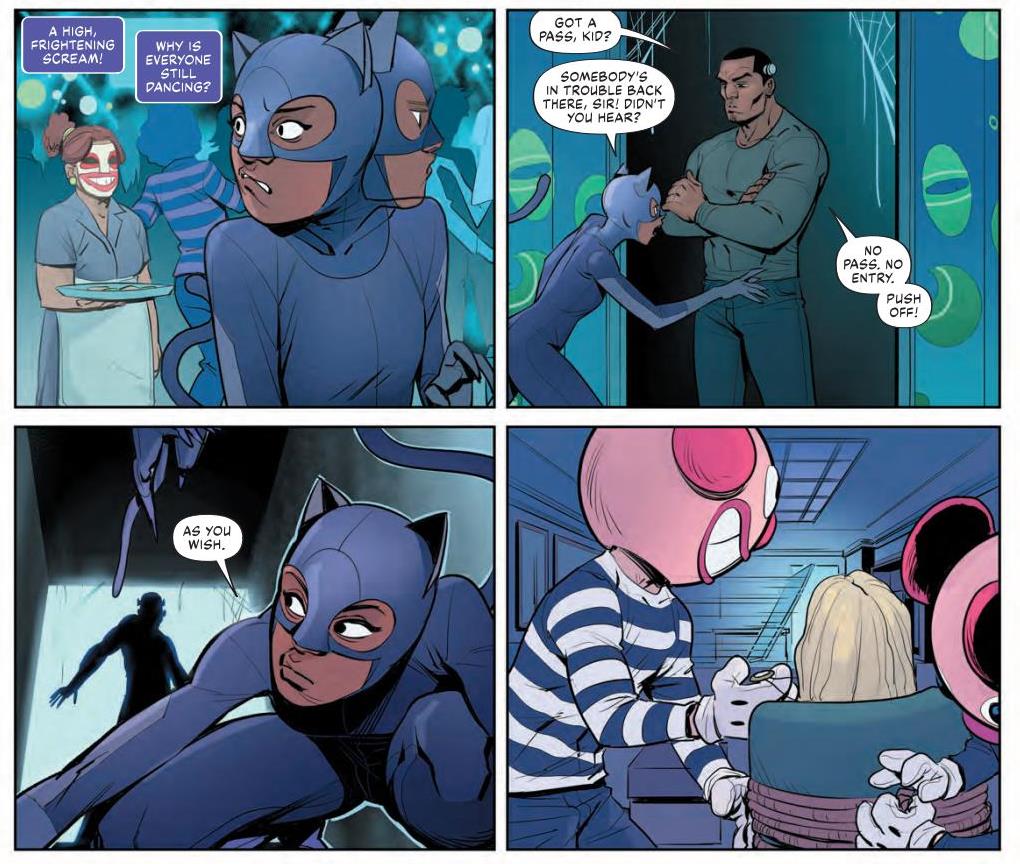
Was Cat Girl something you’d ever heard of before – I’m assuming it was suggested to you as a strip by Keith Richardson rather than you going to him with the idea?
RAMZEE: I actually pitched Keith (Richardson) the Cat Girl story amongst other things. I read Lew Stringer’s fab article on Cat Girl on his amazing blog (Blimey –it’s this article here) which introduced me to the character and the Jinty resource blog is absolutely terrific.
What sort of research did you both do when thinking about getting the strip together?
RAMZEE: I was invited to pitch the weekend of Thought Bubble and was tabling behind comics legend Paul Cornell who gave me his amazing bite-size Ted Talk on British Girls comics. My pal, the comics critic and editor, Claire Napier (who Claire Carter was named after as a thank you!) also gave me her awesome take on British girls comics and what they mean to her. Their takes along with the info on the blogs gave me a good tonal foundation in which to start writing.
When collaborating with artists I always create a PDF of visual references to go along with my script for the artist to bounce ideas off. There were action shots from 80’s Daredevil comics and Police Detective Cathy Carter was heavily based on Cate Blanchett in ‘Oceans 8’!
EN: I initially searched for the classic Cat Girl, to define what kind of references I would need to reinterpret it in my own style, based on what I saw in the original art. After reading the script, Ramsey provided that PDF file with images to see what he had in his mind. But he always gave me the chance to do it as I felt comfortable. I really appreciate when writers provide those kinds of references because as a visual thinker it helps a lot to look into the writer’s mind, and makes one understand what it is wanted to be reached, plus adding some personal details to add to the story.
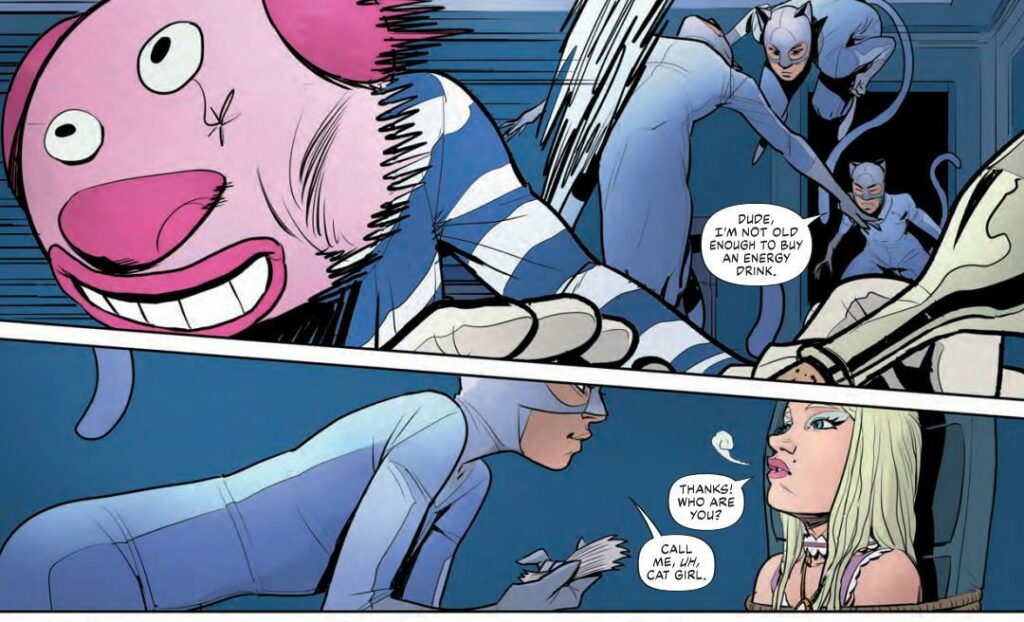
When you were thinking about the strip, did you (as I know writers and artists are want to – it’s a curse) start doing the worldbuilding thing, plotting out future storylines and possible next steps for the character?
RAMZEE: Yes! Keith came up with an amazing idea for a future story that I later fleshed out and whilst doing that, I came up with a few really fun and compelling story ideas that draw from the old Cat Girl comics in an interesting modern way that’ll please readers old and new.
EN: First thing I thought was about the responsibility of being part of a comic reboot. That demands a big quantity of awareness, to know it has to be as awesome as we can do it, so we can honour the classic strip and the hope to see if we can keep going with this title (that I personally loved working on), and make people know this character has a lot of joy and interesting stories to be involved in. When I got the script I knew it was just perfect for me and having those references made imaging every scene clearly.
I don’t know how deep you got into the history of things when it comes to the strip, but what are your thoughts on the richness of the comics world that came about in the 60s and 70s in Britain with the ‘girls’ comics?
RAMZEE: British girls comics were a lot more nuanced in their characterisation than boys comics, for sure, and were every bit as satirical, topical and, dare I say, seditious, as the boys comics were. They were ahead of their time. You can connect Fran of The Floods to Greta Thunberg, for example, and the Concrete Surfer was rail-sliding back when Tony Hawk was in short pants.
EN: Absolutely, for that time girls comics had such a depth of different emotions to experience that made everything have importance and a sense of being, that you had to pay attention to every detail so we could understand the different reads of the same topic. I always found very interesting how female protagonists behave in comics. They have so much power, and so much to learn from another perspective and situations, that I think everybody should be aware of.
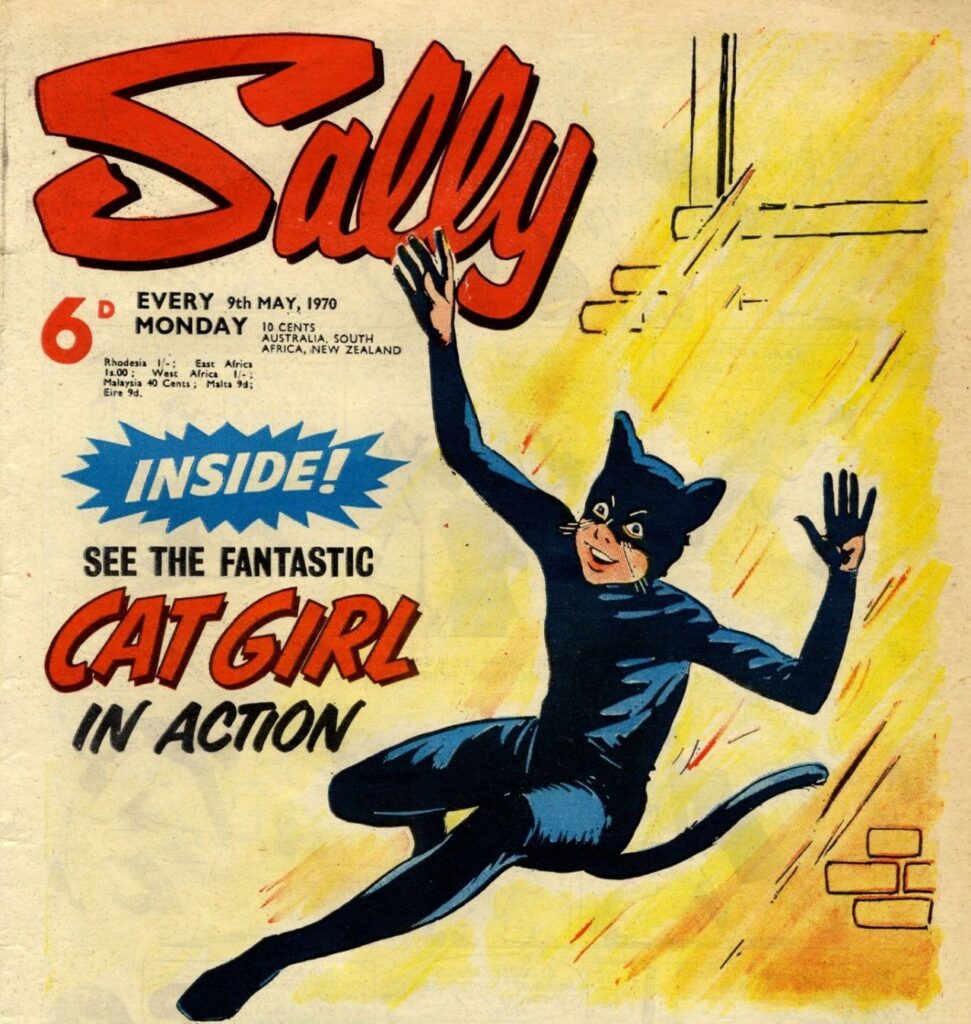
Elkys… I’m always guilty of doing the comic interviewer thing and not going enough into the artwork. I think it’s a symptom of being a writer rather than an artist – not knowing what to ask, that sort of thing. However, one thing that always fascinates me is how you work, the whole process of it all…
Obviously Cat Girl had a very specific look to the strip, coming as it did from one artist, Giorgio Giorgetti.
What do you think of the original artwork and what it achieved and how did you bring your own art to the character? Were there any obvious stylistic changes you made in the process?
EN: The original work is really amazing. I mean, that kind of art quality?! It’s just so impressive. It had a very fluid storytelling, I myself to keep that, as well as some panelling structures.
I have to admit that I got a little scared. I tend to respect the original artist of any comic I have been part of and that makes me work even harder to honour and keep the sense of what was created. Making something where I’m part of its recreation, I feel I can make people pay attention to the original and research about the creators and story.
I have a very versatile drawing style. From my first years working on MoroStudio, I was taught to learn different styles in order to get to be part of any project that needed an artist. So, with this comic having to do with a very athletic protagonist, I wanted to make it look like animation in terms of angles and movements, with a very clean line art and contrasts, to give some noir juvenile comic strip.
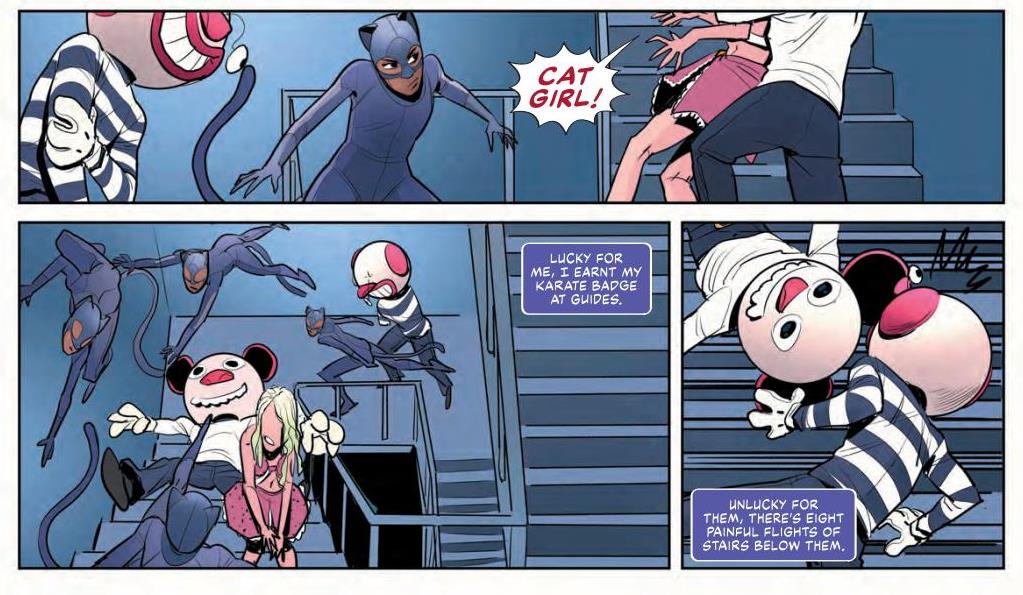
One thing that is nice to do with artists is to discuss process, but even better is the chance for you to show us your process as well. So, how do you go about drawing the way you do?
EN: There is something I cannot explain about my drawing process, and it is that I unconsciously adapt my style depending on the genre and the mood of the story I’m working on. There is this vibe I can feel while reading the comic, that my mind automatically gives me an image representation of what it should look like.
After that analysis, I start sketching the main and secondary characters, to get familiar with their personality and behaviour. I usually take advantage of the different styles I manage to give the story what it is telling me it should look like.
And could you possibly include a few examples, maybe a page of the strip from sketch to finish with a little commentary on it?
EN: Here we have the very first page, sketch first…
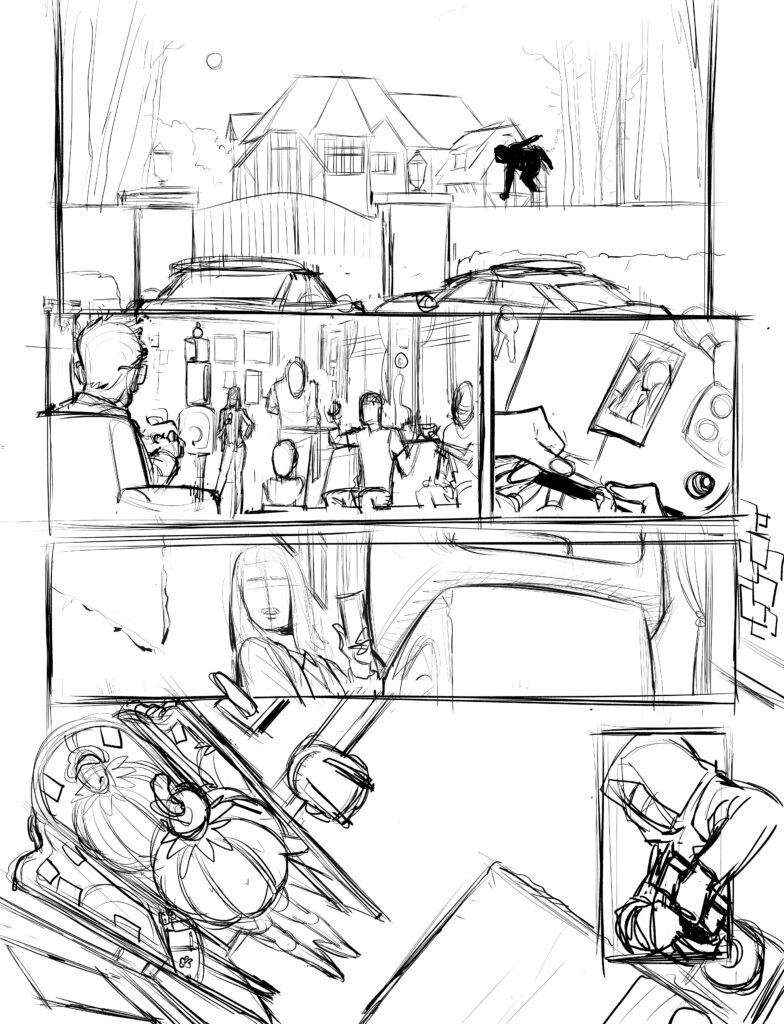
EN: Normally I use a sketchbook to do my thumbnails and make crazy decisions to try to see every possible solution, selecting what’s best to represent the script.
Every sketched page needs to be as detailed as possible, so when I start inking, I’ve already placed every element that is going to be in each panel. And it’s easier for me to get into details and avoid going back and fixing and changing many things.
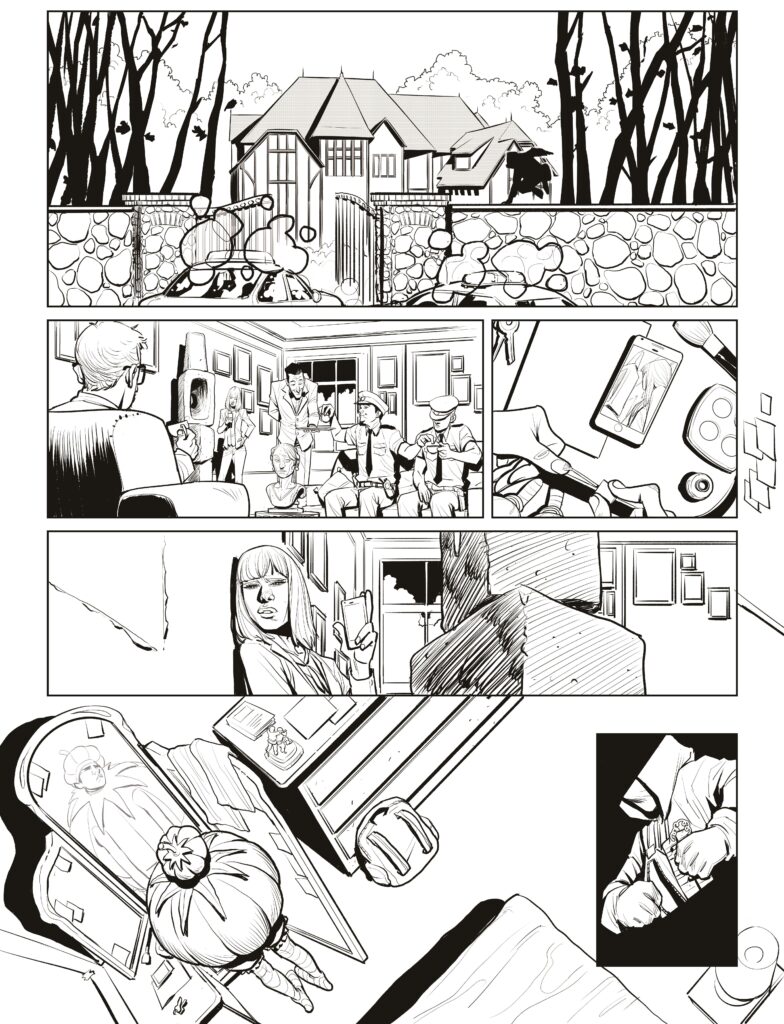
Would you be hopeful at this stage that we could be looking at a more regular publishing schedule, getting more of these sorts of stories out to a wider audience more often?
RAMZEE: I would love to see more. The success of the new Archie line of books, Boom! Studios Lumberjanes and the current boom in all-ages graphic novels initiated by Raina Telgeimeier, has shown that there IS a huge appetite and readership for girls (and all-ages, both genders) stories around the world and the UK has a lot to offer UK readers looking for stories that reflect their experiences and International readers looking for a fresh perspective.
EN: For me, that would be such an honour. As I said before, I love this title and what it could be, as well as how much I learned drawing it. This is literally my best comic up until now.
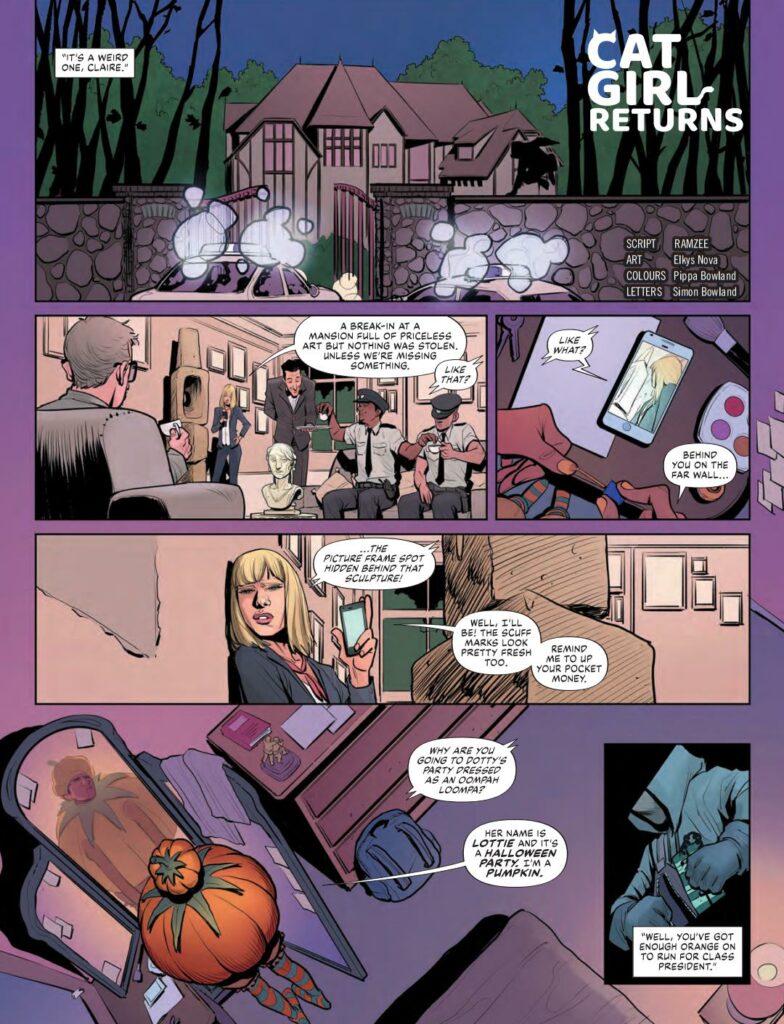
colours by Pippa Bowland, letters by Simon Bowland.
What sort of comics work would you count as the formative works for you, the sort of things that made you fall in love with the medium, the sort of things that set you on the artistic path you’re both on?
RAMZEE: As a kid, I was mostly keen on Saturday morning cartoons and the only comics I read were Tintin, but in my teens, I was big into Jim Lee era X-Men, Ditko & Romita Sr Spider-Man reprints in Marvel Tales, Ann Nocenti’s Daredevil and Gaiman’s Sandman – but Mick McMahon’s work on Judge Dredd, particularly on The Cursed Earth and his 2000 AD covers, were next level.
EN: I found out I just love telling stories, no matter the genre. I am always up to learn new ways of telling stories – I find it joyful to always experiment with different things to understand how they work.
And finally, do feel free to mention here just what we can look forward to from both of you – tell us about the next things we’ll be seeing from you!
RAMZEE: I have a graphic novel called LDN coming out next year by the awesome team at Good Comics and I’m working on a secret YA fantasy serial at the moment with another talented artist that I can’t say much about!
And hopefully more Cat Girl on the horizon and 2000 AD!
EN: For now, I haven’t gotten another proposal from Rebellion, but I am looking forward to continuing working with them. In the meanwhile I am arranging a Sci-fi/post-apocalyptic one shot with a friend of mine, to work on it in our spare time.
Thanks so much to RAMZEE for talking to us. You can find him on Twitter as RamzeeRawkz.
Make sure you check out the new Cat Girl in the pages of Tammy & Jinty Special – available from all good newsagents and comic book stores. Or get it from the 2000 AD web shop and Treasury of British Comics web shop.
And while you’re thinking all things Tammy & Jinty, if you haven’t already seen it, go and grab a copy of the 2019 Tammy & Jinty Special as well.
